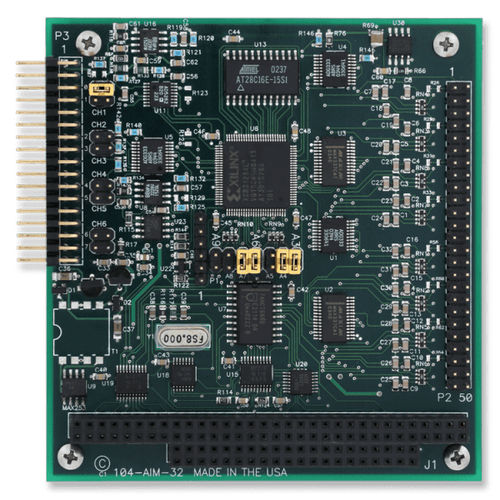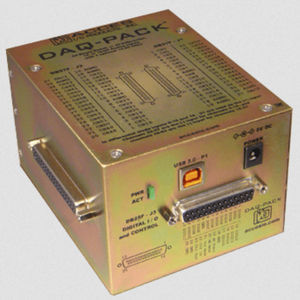
- Robotics - Automation - Industrial IT
- Automation
- Board multiplexer
- ACCES I/O Products, Inc.
Board multiplexer 104-AIM-32analogmulti-channel


Add to favorites
Compare this product
Characteristics
- Type
- board
- Options
- multi-channel, analog
Description
-Designed to pair with an A/D board to increase channel count and signal conditioning capabilities
-32 single-ended or 16 differential inputs
-6 software programmable ranges:
-±25mV, ±50mV, ±0.1V, ±2.5V, ±5V, ±10V
-Up to 7 104-AIM-32s can be stacked per A/D board for up to 224 S.E. or 112 diff. inputs
-+5VDC only operation
-Precision 15VDC sensor excitation
-0 to 70°C operating temperature (-40 to +85°C Optional)
-Input Signal Conditioning Options:
-4-20mA inputs
-RTD measurement
-Thermocouple measurement
-Voltage divider on each input
-RC filters on each input
-Bridge completion configuration
-RoHS Available. Please contact us for ordering information.
The 104-AIM-32 is an analog signal multiplexer conforming to the PC/104 standard. The card will multiplex and condition 16 differential or 32 single-ended analog signals before passing them to an analog-to-digital converter card like the 104-AIO12-8. A system may comprise one to seven of these cards in tandem with one 104-AIO12-8 A/D converter board. The 104-AIM-32 card may be used as part of a large data acquisition system. The 104-AIM-32A Kit consists of one 104-AIM-32 and one 12-bit 8-input A/D board.
A removable screw-terminal block (Model UTBK-50) is optionally available for the termination of the input signals, which can come from a variety of sources: thermocouples (J,K,T,E,S,R, and B), three-wire RTD’s (both 392-and 385-alpha), strain gages, 4-20mA current inputs as well as DC and AC voltage inputs. Optionally, bridge completion circuit, current to voltage circuit.
Catalogs
No catalogs are available for this product.
See all of ACCES I/O Products, Inc.‘s catalogsRelated Searches
- Digital master module
- I O module
- Analog master module
- Digital I O module
- Analog I O module
- Serial I/O
- DIN rail I O module
- Compact master module
- Serial I O module
- IP IO module
- Ethernet I O module
- Network master module
- Configurable I O module
- Compact I O module
- Multiplexer
- Automation IO module
- Network I O module
- I/O card
- Output module
- RS-485 I O module
*Prices are pre-tax. They exclude delivery charges and customs duties and do not include additional charges for installation or activation options. Prices are indicative only and may vary by country, with changes to the cost of raw materials and exchange rates.



